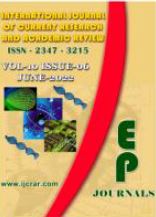Abstract Volume:10 Issue-6 Year-2022 Original Research Articles
 |
Online ISSN : 2347 - 3215 Issues : 12 per year Publisher : Excellent Publishers Email : editorijcret@gmail.com |
2Werer Agricultural Research Center, Ethiopian Institute of Agricultural Research, EIAR
P.O.Box -2003, Werer, Ethiopia
3Welkite Agricultural Research Center, Ethiopian Institute of Agricultural Research [EIAR]
P.O.Box-2003, Welkite, Ethiopia
Though Maize is a staple food crop in Ethiopia, its productivity in Salt affected area is not satisfactory due to the existing soil fertility degradation. The experiments were conducted during 2016 -2018 in Middle Awash Walley areas to evaluate the integrated applications of compost with different levels of nitrogen fertilizer rates and its economic feasibility on maize production. Randomized complete block design was employed with three replications involving 4 levels of nitrogen from compost (23, 46, 69, 92 kg ha-1) and 4 levels of inorganic nitrogen (23, 46, 69, 92 kg ha-1) from urea fertilizers in factorial combination. Compost was prepared following the standard procedure for compost preparation and applied in N-equivalent based. Pre-planting and after planting soil sample was collected at 0-30 cm soil depth and analyzed following the standard procedures. Biomass and grain yield were subjected to analysis of variances using SAS software program. Partial budget analysis technique was applied on the yield results. Analysis of variance showed a significant difference for all parameters (plant height, biomass and grain yield of maize) due to the main factor of treatments applied. Higher grain yields were recorded across the treatments due to the integrated application of compost and inorganic fertilizer. The combined application of 46-kg ha-1 N from Urea and 23-Kg ha-1 N from compost is economically acceptable and can be considered as alternative recommendation for the area to enable sustainable production and soil health improvement.
How to cite this article:
Diriba Megersa Soboka, Mekuria Bekele and Bethel Nekir. 2022. Enhancing the Productivity of Salt-affected Soil through Application of Integrated Organic and Inorganic Fertilizers: The Case of Middle Awash Valley, Ethiopia.Int.J.Curr.Res.Aca.Rev. 10(6): 101-110doi: https://doi.org/10.20546/ijcrar.2022.1006.009



Quick Navigation
- Print Article
- Full Text PDF
- How to Cite this Article
- on Google
- on Google Scholor
- Citation Alert By Google Scholar
